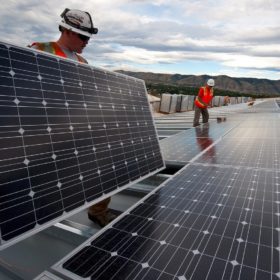
A University of South Australia study has shown that solar owners selling electricity to the grid should position their panels to minimize the discrepancy between peak use and peak production.
A recent University of South Australia (UniSA) study shows that simply increasing solar penetration is not good enough, as the panels need to be orientated to minimize the discrepancy between times of peak use and peak production.
“Solar panels on residential dwellings are typically installed facing the equator to maximize the energy collected, but the power generated by an equator-facing panel peaks at around midday, whereas residential loads typically have peaks in the morning and afternoon,” said UniSA solar researcher Kirrilie Rowe. “It is possible to minimize the shortfall between load and generation. This benefits the end-user by decreasing the amount of electricity required to be imported, and the stability of the grid by decreasing the amount of variability between peak and low loads.”
The Western Australian government has already heeded the rationality of Rowe’s argument. It recently launched the Distributed Energy Buyback Scheme to encourage the uptake of solar on west-facing rooftops, as they receive sunlight at times when demand is highest and therefore most profitable to export to the grid.
Panel orientation may sound obvious, but Australia need to work on such solar basics. Electricity isn’t in high demand at midday, when a north-facing panel is at its peak.
“The real challenge now facing the solar industry is finding ways to balance production and consumption by maximizing self-consumption for the solar panel owner,” said Rowe.
Solar orienteering
Of course, as solar penetration continues to increase, the returns on “feed-in tariffs” will necessarily fall. One easy way to stem this reduction is to install solar in an orientation that plays to a given rooftop’s geographic strengths.
Those considering solar panels on their rooftops already have a diverse solar toolkit at their disposal. For instance, OpenSolar, or alternatively – through the use of drones such as DroneDeploy – potential solar customers can determine the optimal orientation of solar panels in their rooftops in a matter of minutes. By incorporating access to Nearmap imagery, OpenSolar provides a purpose-built digital toolkit to streamline the design-and-quote process for installers by generating professional quotes, while also incorporating Nearmap imaging of rooftops as they will appear with solar installed.
OpenSolar co-founder Andrew Birch recently said he was excited about the next iteration of Nearmap in the OpenSolar app, as it will create a 3D immersive experience to allow solar installers to view digital surface maps of properties and their surroundings. Using the orientation of the roof and its dimensions, they’ll be able to automatically calculate roof pitch, for example. They’ll also be able to use “ray tracing” of the sun as it moves across rooftops and is filtered through nearby trees, to accurately estimate what solar output will be.
Ultimate time
Rowe and one of his fellow researchers, Associate Professor Peter Pudney, have worked out the optimal orientation of solar panels for a community of 29 individual dwellings and a residential block of 42 apartments. “Our analysis uses detailed load data and detailed irradiance data and shows that optimal panel placement for self-consumption is rarely towards the equator,” Rowe concluded.
Of course, if your rooftop is small and you’re only producing for your own household, then facing the panel north is best. “But as the panel area increases, it becomes better to face the panels acing north-west to meet the afternoon loads, and if even more panel area is available, then panels should be aced north-east and west,” Rowe said.
His research demonstrates that solar panel orientation is one elegantly simple solution.
“By orienting panels in different directions rather than just facing the equator, it’s possible to minimize the shortfall between load and generation,” said Rowe. “This benefits the end-user by decreasing the amount of electricity required to be imported, and the stability of the grid by decreasing the amount of variability between peak and low loads.”
Of course, future work will “incorporate energy storage into the model,” he said. But as batteries remain expensive for many, “the real value of solar self-consumption will continue to rise” and this simple orientation strategy can be easily adopted for new installs or upgrades for existing systems.
Lắp đặt điện mặt trời Khải Minh Tech
https://ift.tt/2X7bF6x
0906633505
info.khaiminhtech@gmail.com
80/39 Trần Quang Diệu, Phường 14, Quận 3
Lắp đặt điện mặt trời Khải Minh Tech
https://ift.tt/2ZH4TRU
Không có nhận xét nào:
Đăng nhận xét